菝葜的抗菌和抗炎作用。辣木;和Phyllanthus amarus Schumach。& Thonn。提取
IF 1.9
4区 医学
Q2 INTEGRATIVE & COMPLEMENTARY MEDICINE
引用次数: 0
摘要
导言:越来越多的证据表明,胃肠道的慢性炎症可能是由病原体感染引起的,从而导致牙周病等破坏性炎症。本研究旨在探讨月桂树(Thunbergia laurifolia Lindl.,TLE)、苋菜(Phyllanthus amarus Schumach. & Thonn.,PAE)和油杉(Moringa oleifera Lam.,MOE)乙醇提取物的抗菌和消炎特性。(方法采用磁盘扩散法和肉汤稀释法评估粗乙醇提取物对蜡样芽孢杆菌、金黄色葡萄球菌、大肠杆菌、绿脓杆菌和霍乱弧菌的抗菌活性。在没有脂多糖和有脂多糖的情况下,通过测量 24 小时内 THP-1 巨噬细胞中白细胞介素-6(IL-6)、肿瘤坏死因子-α 和单核细胞趋化蛋白-1(MCP-1)的分泌水平,检测草药提取物的抗炎特性。结果所有草药提取物都对蜡样芽孢杆菌、金黄色葡萄球菌和霍乱弧菌具有抗菌活性,但对大肠杆菌和绿脓杆菌无效。抑菌效果与剂量有关,最低抑菌浓度(MIC)值为 625 至 5 000 微克/毫升,最低杀菌浓度值为 625 至 10 000 微克/毫升。MOE 对霍乱弧菌的抗菌活性最高(MIC = 625 µg/ml),而 PAE 对蜡样芽孢杆菌的抑制作用最强(MIC = 625 µg/ml)。此外,低至 200 µg/ml 的 PAE 和 TLE 可完全抑制 IL-6 的分泌,并以浓度依赖的方式减少肿瘤坏死因子-α(TNF-α)和 MCP-1 的分泌。本文章由计算机程序翻译,如有差异,请以英文原文为准。
Antibacterial and anti-inflammatory effects of Thunbergia laurifolia Lindl., Moringa oleifera Lam. and Phyllanthus amarus Schumach. & Thonn. extracts
Introduction
There is increasing evidence suggesting that chronic inflammation in the gastrointestinal tract may be caused by pathogenic infections, leading to destructive inflammatory conditions such as periodontal disease. This study aimed to investigate the antimicrobial and anti-inflammatory properties of ethanolic extracts from Thunbergia laurifolia Lindl. (TLE), Phyllanthus amarus Schumach. & Thonn. (PAE), and Moringa oleifera Lam. (MOE).
Methods
The antimicrobial activity of crude ethanol extracts was assessed using disk diffusion and broth dilution methods against Bacillus cereus, Staphylococcus aureus, Escherichia coli, Pseudomonas aeruginosa, and Vibrio cholerae. The anti-inflammatory properties of herbal extracts by measuring the level of interleukin-6 (IL-6), tumour necrosis factor-alpha, and monocyte chemoattractant protein-1 (MCP-1) secretion in THP-1 macrophage cells over 24 hours, both in the absence and presence of lipopolysaccharide.
Results
All herbal extracts exhibited antibacterial activity against B. cereus, S. aureus, and V. cholerae, but were ineffective against E. coli and P. aeruginosa. The inhibitory effects were dose-dependent, with minimum inhibitory concentration (MIC) values ranging from 625 to 5 000 µg/ml and minimum bactericidal concentration values ranging from 625 to 10 000 µg/ml. MOE showed the highest antibacterial activity against V. cholerae (MIC = 625 µg/ml), while PAE exhibited the most inhibitory effects against B. cereus (MIC = 625 µg/ml). Additionally, PAE and TLE as low as 200 µg/ml completely inhibit IL-6 secretion and reduce Tumor Necrosis Factor-alpha (TNF-α) and MCP-1 secretion in a concentration-dependent manner.
Conclusions
All three herbal extracts have the potential to attenuate the secretion of inflammatory cytokines and exhibit antibacterial activity that may prevent foodborne infections.
求助全文
通过发布文献求助,成功后即可免费获取论文全文。
去求助
来源期刊

Journal of Herbal Medicine
INTEGRATIVE & COMPLEMENTARY MEDICINE-
CiteScore
3.90
自引率
0.00%
发文量
94
期刊介绍:
The Journal of Herbal Medicine, the official journal of the National Institute of Medical Herbalists, is a peer reviewed journal which aims to serve its readers as an authoritative resource on the profession and practice of herbal medicine. The content areas of the journal reflect the interests of Medical Herbalists and other health professionals interested in the clinical and professional application of botanical medicines. The objective is to strengthen the research and educational base of herbal medicine with research papers in the form of case studies, original research articles and reviews, monographs, clinical trials and relevant in vitro studies. It also publishes policy statements, opinion pieces, book reviews, conference proceedings and profession related information such as pharmacovigilance reports providing an information source for not only the Herbal Practitioner but any Health professional with an interest in phytotherapy.
 求助内容:
求助内容: 应助结果提醒方式:
应助结果提醒方式:


